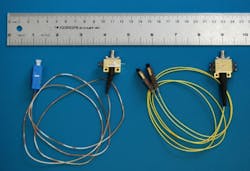Discovery Semiconductors InGaAs photodiode modules return to Earth after 18 months on the ISS
Ewing, NJ--A high-speed indium gallium arsenide (InGaAs) photodiode and a balanced photodiode (two photodiodes with a difference amplifier) made by Discovery Semiconductors returned to Earth after spending 18 months on the International Space Station (ISS) in a radiation-exposure study.
The two modules were part of the Materials International Space Station Experiment (MISSE) 7 mission launched on the Space Shuttle Atlantis (STS-129) on November 16, 2009, and returned on the Space Shuttle Endeavor (STS-134) on June 1, 2011. NASA’s Langley Research Center (Hampton, VA) launched them as part of their lidar transceiver components and recently released them to Discovery Semiconductors for further study.
"A suitcase shaped, rugged, flight-worthy box known as Passive Experiment Containers (PECs) is used to transport the selected materials to and from the ISS," explained Narasimha Prasad, aerospace technologist at NASA Langley. "The MISSE 7 mission was managed by the NASA Glenn Research Center with Naval Research Laboratory, Boeing, and NASA Langley playing significant roles. In case of MISSE 7 package, there were two sections, 7A and 7B. PEC 7A's orientation is zenith/nadir (space facing/earth facing), while PEC 7B faces ram/wake (forward/backward) relative to the ISS orbit. NASA Langley sent a package with several LIDAR transceiver components on PEC 7B; Discovery Semiconductors' two photodiode modules were part of this package facing wake side, primarily used to study for UV and radiation exposure effects."
"MISSE missions are unique and we are grateful to NASA Langley for this opportunity," said Abhay Joshi, president and CEO of Discovery Semiconductors. "I have worked on space missions before, but the devices launched rarely come back to earth, as most spacecrafts get destroyed in the atmospheric re-entry after their missions are over. MISSE 7 has given us a great opportunity to study these InGaAs photodiodes and balanced photodiodes which went through the STS-129 launch, 18 months of stay on ISS, and then re-entry back to earth on STS-134. We have started Post Flight tests on these devices, and our preliminary analysis shows the InGaAs photodiodes have been surprisingly intact under the influence of UV, radiation, as well as thermal cycling in space. Over the next few months, we will be studying carefully not only the electro-optical characteristics of these InGaAs photodiodes, but also other parts of the modules such as fiber-optic cables, fiber-optic connectors, metal housings, millimeter-wave substrates, solder joints, amongst other things. This data will allow us to design even better and rugged InGaAs photodiode modules for future space flights."
